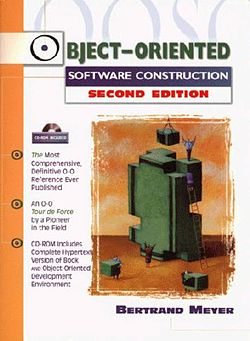- Object-Oriented Software Construction
-
Object-Oriented Software Construction 
Author(s) Bertrand Meyer Subject(s) software object-oriented programming Publisher Prentice Hall Publication date 1988, 1997 Pages 1254 + xxviii ISBN ISBN 0-13-629155-4 (1997 ed.) OCLC Number 36187052 Dewey Decimal 005.1/17 21 LC Classification QA76.64 .M493 1997 Object-Oriented Software Construction is a book by Bertrand Meyer, widely considered a foundational text of object-oriented programming[citation needed]. The first edition was published in 1988; the second, extensively revised and expanded edition (more than 1300 pages), in 1997. Numerous translations are available including Dutch (first edition only), French (1+2), German (1), Italian (1), Japanese (1+2), Polish (2), Romanian (1), Russian (2), Serbian (2), and Spanish (2).[1] The influence of the book can be measured by the thousands of citations[2] of the book in computer science literature[neutrality is disputed]. The book won a Jolt award in 1994. [3]
Unless otherwise indicated, descriptions below apply to the second edition.
Contents
Focus
The book, known among its fans as "OOSC", presents object technology as an answer to major issues of software engineering, with a special emphasis on addressing the software quality factors of correctness, robustness, extendibility and reusability. It starts with an examination of the issues of software quality, then introduces abstract data types as the theoretical basis for object technology and proceeds with the main object-oriented techniques: classes, objects, genericity, inheritance, Design by Contract, concurrency, and persistence. It includes extensive discussions of methodological issues.
Table of contents
Preface etc.
Part A: The issues- 1 Software quality
- 2 Criteria of object orientation
Part B: The road to object orientation
- 3 Modularity
- 4 Approaches to reusability
- 5 Towards object technology
- 6 Abstract data types
Part C: Object-oriented techniques
- 7 The static structure: classes
- 8 The run-time structure: objects
- 9 Memory management
- 10 Genericity
- 11 Design by Contract: building
- reliable software
- 12 When the contract is broken:
- exception handling
- 13 Supporting mechanisms
- 14 Introduction to inheritance
- 15 Multiple inheritance
- 16 Inheritance techniques
- 17 Typing
- 18 Global objects and constants
Part D: Object-oriented methodology:
applying the method well- 19 On methodology
- 20 Design pattern: multi-panel
- interactive systems
- 21 Inheritance case study: “undo”
- in an interactive system
- 22 How to find the classes
- 23 Principles of class design
- 24 Using inheritance well
- 25 Useful techniques
- 26 A sense of style
- 27 Object-oriented analysis
- 28 The software construction process
- 29 Teaching the method
Part E: Advanced topics
- 30 Concurrency, distribution, client-server
- and the Internet
- 31 Object persistence and databases
- 32 Some O-O techniques for graphical
- interactive applications
Part F: Applying the method in various
languages and environments- 33 O-O programming and Ada
- 34 Emulating object technology in non-O-O environments
- 35 Simula to Java and beyond: major O-O
- languages and environments
Part G: Doing it right
- 36 An object-oriented environment
- Epilogue, In Full Frankness Exposing the Language
Part H: Appendices
- A Extracts from the Base library
- B Genericity versus inheritance
- C Principles, rules, precepts and definitions
- D A glossary of object technology
- E Bibliography
Index
Notation
The first edition of the book used Eiffel for the examples and served as a justification of the language design choices for Eiffel. The second edition also uses Eiffel as its notation, but in an effort to separate the notation from the concepts it does not name the language until the Epilogue, on page 1162, where "Eiffel" appears as the last word. A few months after publication of the second edition, a reader posted on Usenet[citation needed] his discovery that the book's 36 chapters alternatively start with the letters "E", "I", "F", "F", "E", "L", a pattern being repeated 6 times. In addition, in the Appendix, titled "Epilogue, In Full Frankness Exposing the Language" (note the initials), the first letters of each paragraph spell out the same pattern.
References
- ^ Web search, August 2006
- ^ The ACM's Guide to Computing Literature counts close to 400 citations for the second edition alone in computer science journals and technical books; Google Scholar (February 2008) lists over 4600 citations; the book appears as number 35 in the Citeseer list of all-time most cited works (books, articles etc.) in computer science, with 1260 citations (September 2006).
- ^ Jolt winners 1997
- Meyer, Bertrand (1988). Object-Oriented Software Construction. Prentice Hall. ISBN 0136290493.
- Meyer, Bertrand (1997). Object-Oriented Software Construction, second edition. Prentice Hall. ISBN 0-13-629155-4.
External links
Categories:- 1988 books
- 1997 books
- Object-oriented programming
- Computer books
Wikimedia Foundation. 2010.
